Pisa - Engaging, Even Though the Bell Tower Leans
![]()
Poor Pisa! It is known throughout the world for just one rather eccentric building - the bell tower of the Duomo, better known as the Leaning Tower.
Certain that there must be more to this smaller (population 90,000) Tuscan town, we left Firenza, taking the pleasant train ride along the Fiume Arno (Arno River) through several small towns, past fields of corn, grain and sunflowers with their faces turned toward the sun. The Pisa train station was small but it hosted a McDonalds and an Italian cafe (below left). We headed out to find the Hotel Milano just a block away, checked in, dumped our stuff in the pleasant room and walked into town to find lunch.
We immediately discovered that the main square, Piazza Vittorio Emanuele II, with its elegant buildings was the middle of a construction site, and rather unpleasant to walk around (below right). We did find a nice cafe for lunch however and shared a hope that we would return to see how all the work turns out.
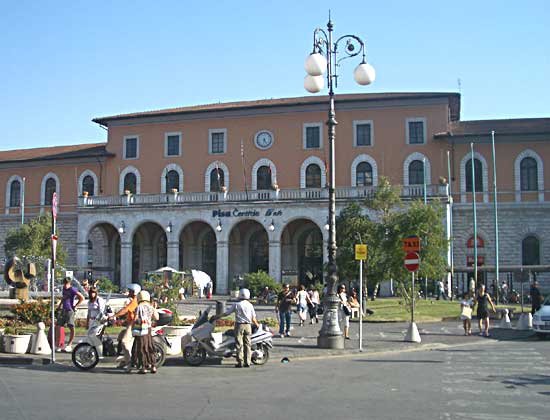
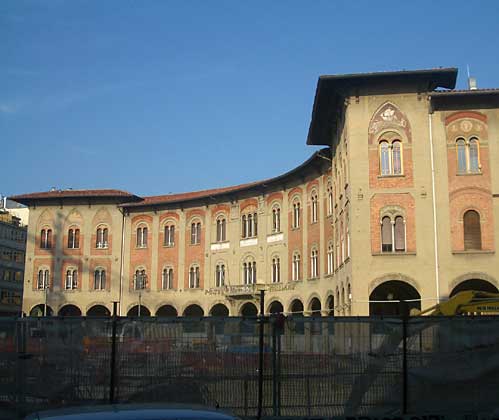
Anxious to see the city, we headed east to find the walls of the old city, now a town park. Continuing on, we reached the Fiume Arno, now contained in its channel. The river front road offered a nice walk past elegant Renaissance town homes.
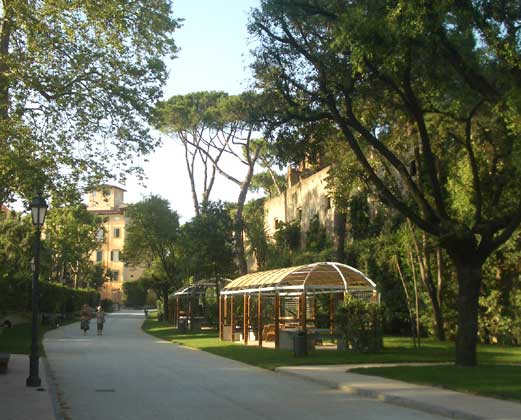
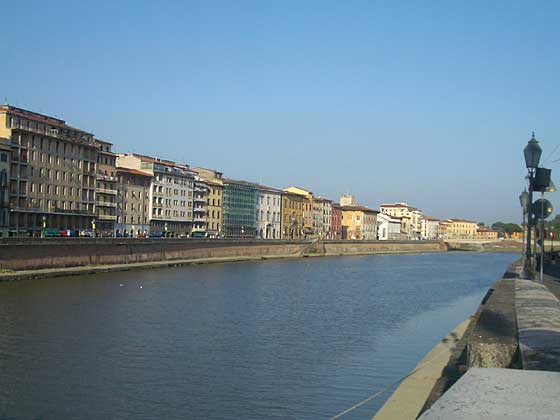
We discovered that the Ponte di Mezzo, the main bridge, was closed to motorized traffic in preparation for the Gioco del Ponte the next Sunday. This is Pisa's annual traditional contest of strength where opposing teams of strong men struggle to push a 7 ton carriage on rails across the other team's' end line. Intrigued, we hoped we would be able to watch and be sure to come back.
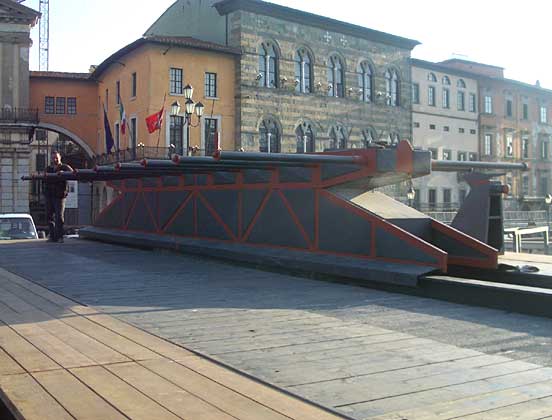
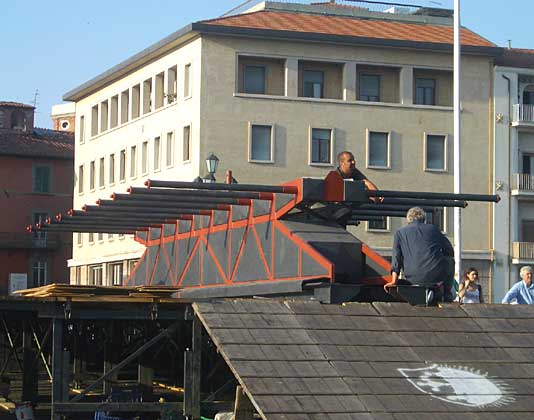
The next day the Campo del Miracoli was calling. We rode the Pisa City bus, walked through the large arch into the walled Campo. WOW! The great dome of the Duomo and the walls of the Baptistry gleamed white in the bright sunlight surrounded by green lawns. At first, the bell tower was lost beyond the Duomo, but as we walked a few yards further, there is was - cocked at a perilous angle - just like all the pictures we had seen through life, which never really prepare you for the real thing!
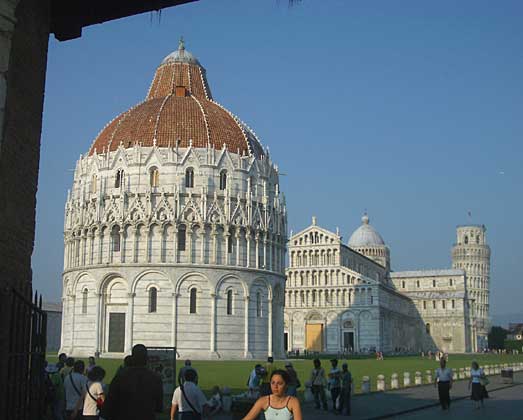
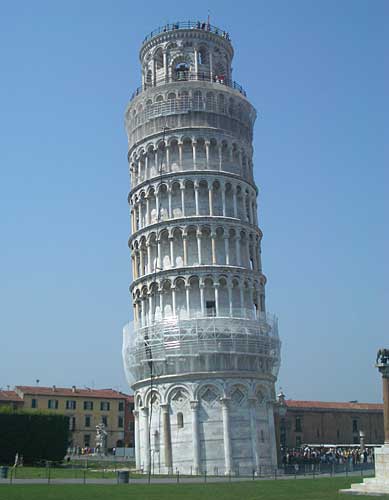
We walked quickly past the souvenir shops and hoards of tourists posing for pictures as if they were holding up the leaning tower, and found a quiet, shady corner to view this wonder. We learned that the bell tower had begun to lean while it was being built, in the 1170s. The engineers of the day made desperate design modifications to correct the tilt and completed the first three stories, but the lean got worse. A century later, a consortium of architects and engineers concocted a plan to resume construction of three more stories, tilted to counterbalance the first three. In 1350, the bell chamber and bells were completed so the bell tower could finally send out chimes.
But the tilting continued until 1990 when a major and successful stabilization effort was launched so that Pisa's famous tower may continue to amaze and entertain visitors today and into the future. Visitors are again allowed to climb the tower and experience its unusual slant. Note the different depth of the foundation on the two sides.
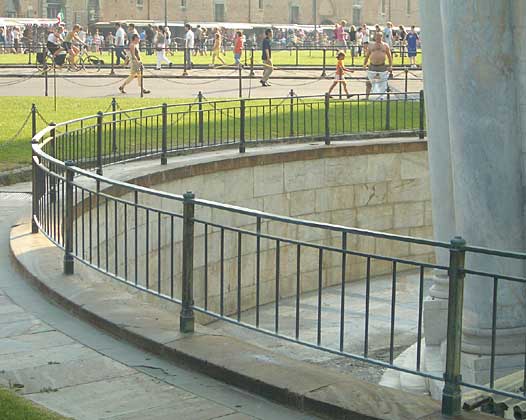

On this and later visits, we continued to admire and photograph this assembly of elegant buildings. With changing light different viewpoints, it never ceased to amaze.
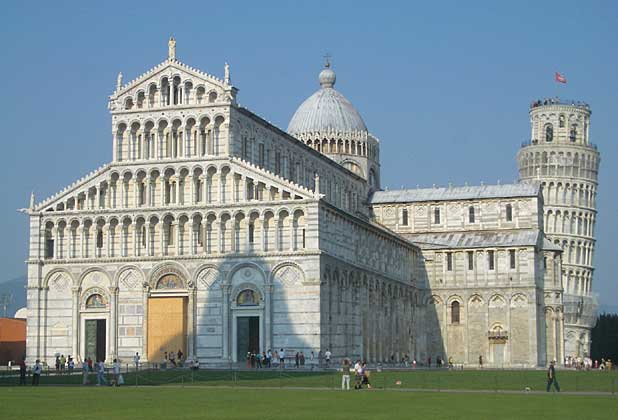
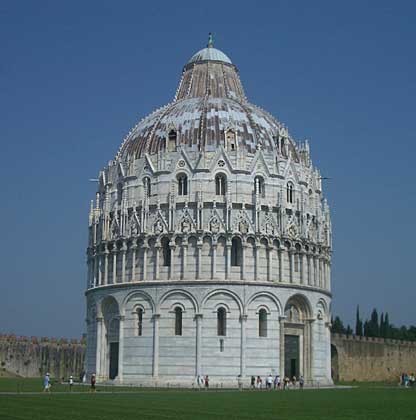

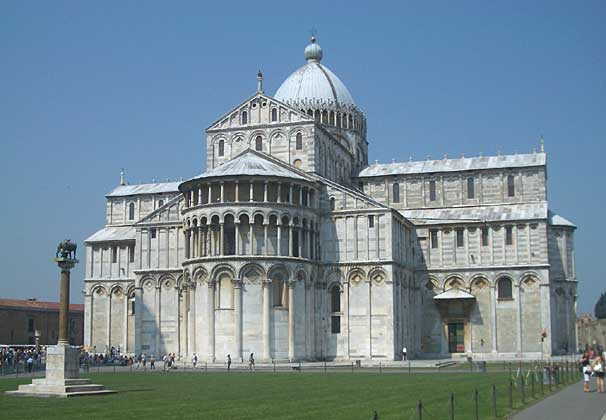
A short walk through the narrow streets of Pisa took us to the Orto Botanico, a quiet cool garden tucked inside high walls. This garden was founded in 1543 by the Chair of Botany at Universita' di Pisa to enable students to study the plants of the world. After a rocky beginning - the garden was moved twice and arrived at its present location in 1595. The garden has continued to flourish and today offers specimens from all over the world for study and research, and in many cases, also provides species preservation as more plant species become endangered in the wild.
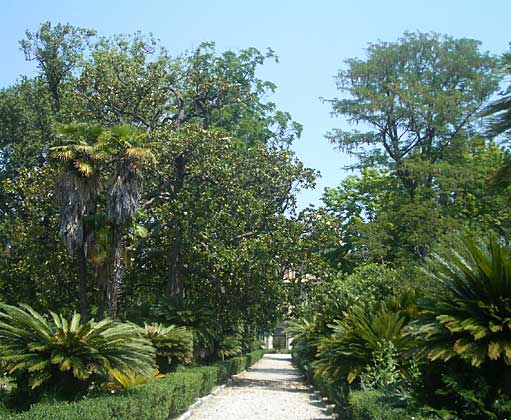
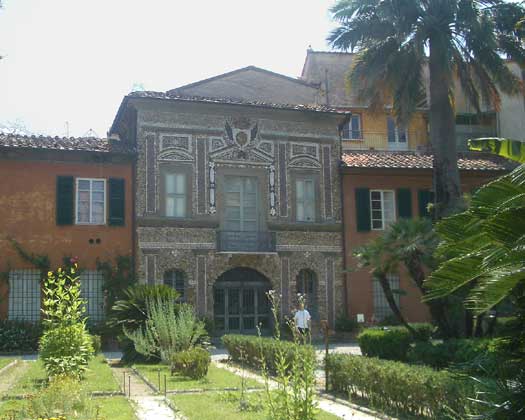
We continued through the narrow streets of Pisa's Centro Storico, finding elegant buildings, nicely mixed with parks, retail and residential spaces and old churches. Further on we joined throngs of people along a main pedestrian shopping street.
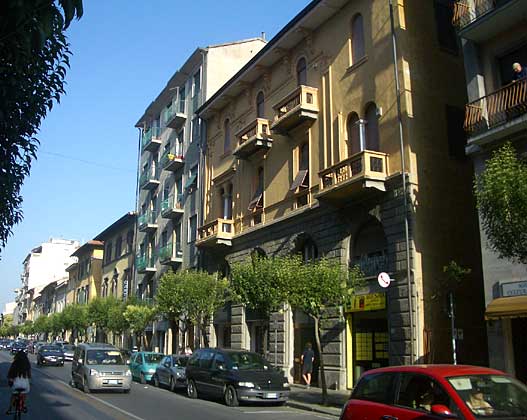
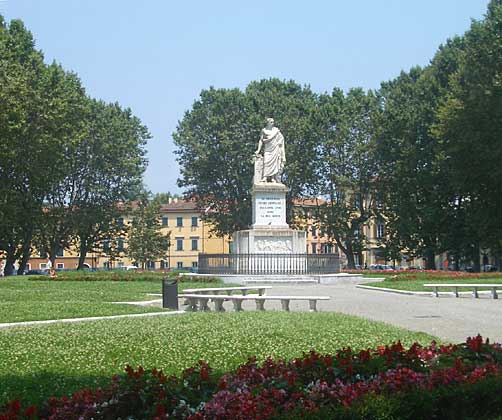
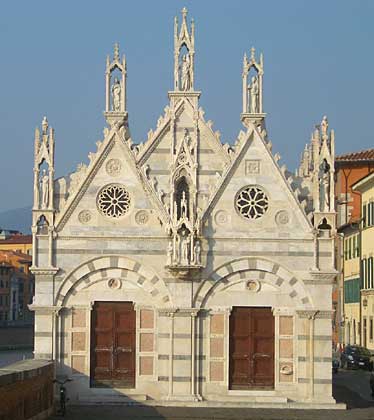
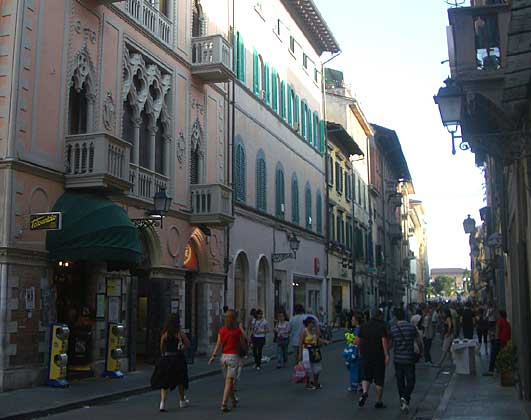
The next morning, it was a bit more comfortable so we set out to explore the east side of town outside the Centro Storico (Historic District) and wandered through a pleasant residential neighborhood of 4 to 5 story apartment buildings with gardens hidden behind. We stopped at an umbrella-ed cafe for cafe latte and continued our walk along a canal under the trees. Again, we hunkered inside during the hot afternoon.
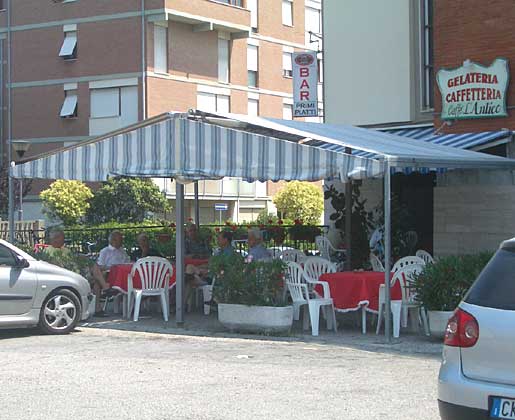
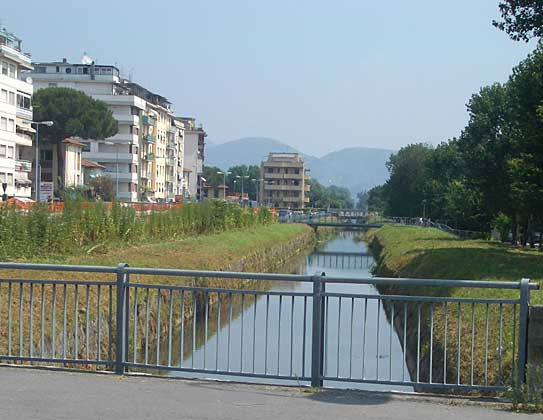
Back in the hotel, after dinner, we turned on the TV and discovered a local channel that was broadcasting the Gioco del Ponte event. We were able to watch the action up close, the men's muscled efforts and grimaces, the play by play announcements! But, alas, we have no pictures to share!
After the big event, the programming moved to the final game of the Euro2008 (calcio or soccer) match between Germany and Spain. Great game - Spain won! Over the past two summers we have become avid soccer fans and watch the games on TV whenever we can, often in neighborhood cafes. We usually root for the local team - it's easier to keep our fellow patrons as friends that way.
Studying our history a bit more, we learned that silt from the Arno, deposited over the centuries, gradually ruined Pisa's harbor and moved the beach west, away from the city. Wishing to experience the ocean, we took a train to Viareggio, a quintessential beach resort town up the coast. A walk along a charming boulevard, lined with oleander and shops and apartments brought us to the promenade (below left). We discovered that access to the beach was only through the beachfront cafes and bathhouses, with their vast arrays of beach chairs under umbrellas. We picked one for a delightful lunch but only a distant view of the sea under the umbrellas (below right)! A walk down the promenade to the marina offered us views of the sea past a mass of boats. After a gelato stop (Yum!) we returned to the station and caught the train back to Pisa.
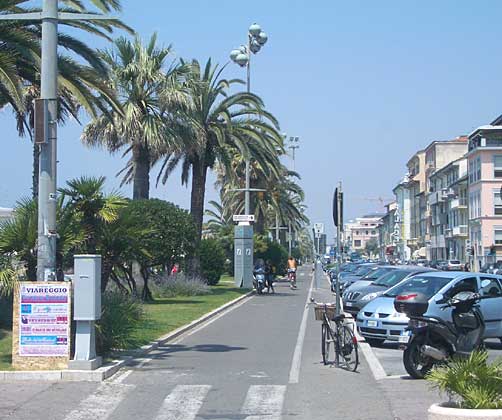
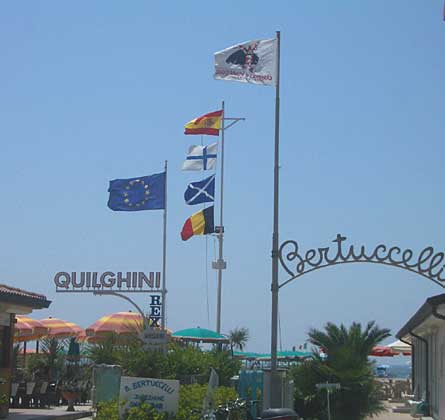
Reflecting on our stay in Pisa, the first "normal" Italian city we had visited, we agreed that many of the pastel colored buildings of the Centro Storico could use some refurbishment to revive their historic charm, that intangible attribute. Still, the elegant old buildings and narrow streets captivated us. The city centre has a large pedestrian area of retail shops, well visited, and the Campo del Miracoli is nicely separated from the rest of the city, making it easy for residents to decide how much tourist contact they want to endure.
We noted that the city is struggling to deal with too many cars by offering a bus service that is amazingly comprehensive and user friendly. As to cars, Italians have a wide range of models to select from and most are small and gas efficient. We might wish for fewer cars (and certainly even fewer motorcycles) but at least Italians are able to choose an efficient one and their per capita green house gas emissions are consequently lower than the USA's.
We agreed that Pisa is a very pleasant place to visit, but now we were anxious to proceed to Roma to settle into our apartment where we would spend the next month.
A Walk through the Cinque Terre
One day, during our stay in Pisa, we packed water and snacks, put on our walking shoes and headed by train to the Parco Nazionale delle Cinque Terre.
Click here to read our story.
Click here to return to our More Travels in Europe - Summer 2008 page
![]()